Small reactors as an alternative to modern power reactors
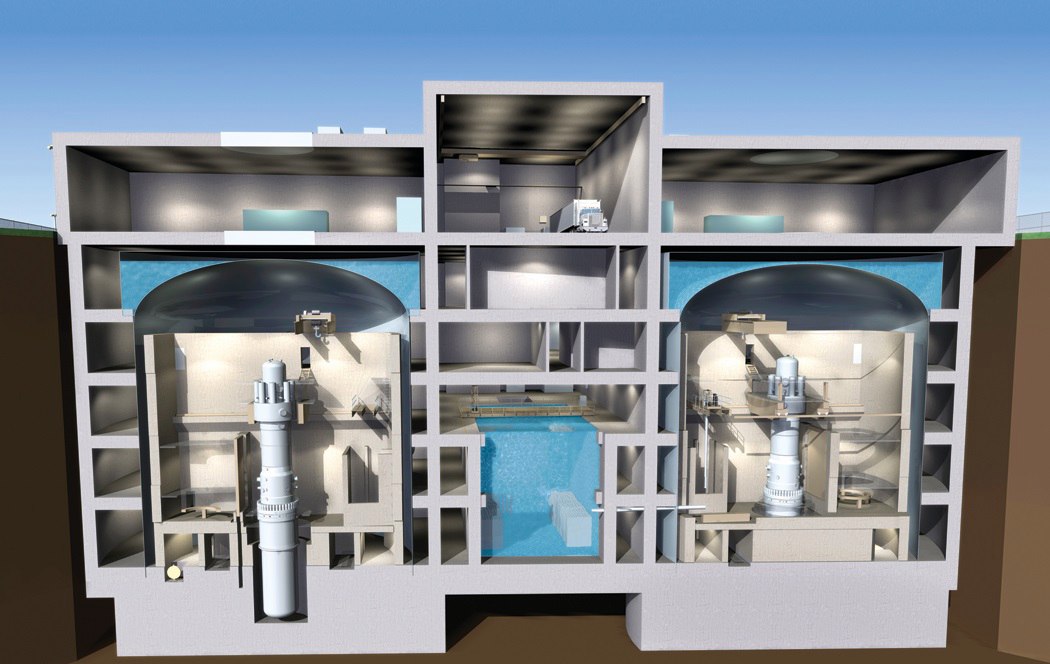
Small modular reactors - one of the most popular areas of development of nuclear energy and reactor technology.
Over 70 years of existence, nuclear power reactors have taken a strong position in the global balance of power generation. Their capacity increased from a few megawatts to almost two gigawatts (although there were projects and larger).
')
A modern nuclear power plant is not only a power unit with a reactor and a turbo-generator. This is a focused cluster of workshops and industries that serve to ensure the work of such a powerful unit at the proper level. Think about it: at any NPP there is not only a large number of safety systems (which, by the way, obey the principle of redundancy), but also systems providing and maintaining these safety systems. About the number and variety of systems for normal operation just keep quiet.
The number of personnel at such facilities averages about 1,000 people per power unit. And if additional production facilities may be present at the NPP site, for example, a radioactive waste reprocessing complex, a separate spent fuel storage facility or even a desalination plant, then the number of personnel will only increase.

Bruce NPP (Canada) - 6,232 MW (e). The photo shows the plant for the production of heavy water.
It would seem that if the station is economically profitable and generates a large amount of electricity, what's the catch?
Modern NPPs, like large industrial complexes, have significant drawbacks. First of all, this is a huge cost for the construction of such a complex. For example, the cost of construction of the power unit No. 3 of the Olkiluoto NPP changed from 3 to 8.5 billion dollars (it is worth considering the fact that some supporting workshops and qualified personnel already exist at the station). For comparison - the cost of the LHC was $ 6 billion.
The operation and maintenance of such giants requires not only the operating organization, but also the supervisory authority, a large number of institutes and research centers supporting operation and security.
In countries with low power consumption, nuclear power plants in their current form will be economically unprofitable. I think that readers can imagine how big the costs are for the owners of nuclear power plants after the end of their service life, when the plant needs to be disassembled, recycled and packaged waste from electricity production at nuclear power plants. Experience shows that the decommissioning of large nuclear power plants usually lags behind in terms.
Another reality
In parallel with large power installations, dozens of installations for military programs developed, for example, reactors for submarines (up to 190 MW) and research reactors. All this gave impetus to the development of small reactors in the future.
So what is it? In the definition of the IAEA, "small" - reactors with an electrical capacity of up to 300 MW, "medium" - up to 700 MW. Nevertheless, “SMR” is most often used as an acronym for a “small modular reactor”, intended for serial construction, as an alternative to the complex construction of an “atomic island” with its bulky rooms and enclosures.
DFMs are small modular reactors — plants developed using integrated technologies (reactors with pumps (or without) and steam generators in the same package), which are planned to be manufactured in factories, using all the economic advantages of mass production. They can be built independently of each other or as modules in a larger complex, with the addition of power gradually as needed.
Small reactors can be located anywhere and in any way.
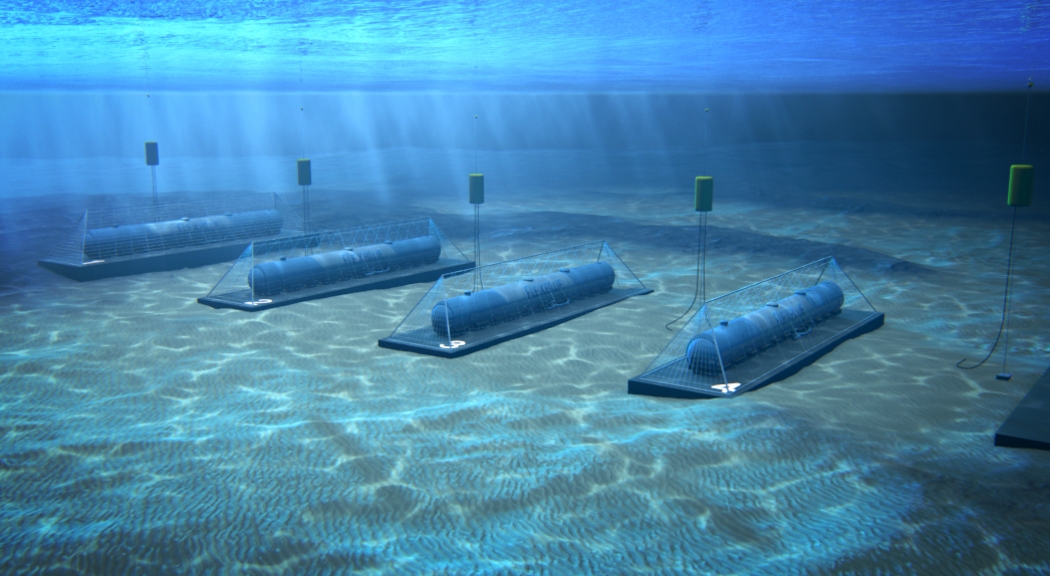
The Flexblue project is an energy module located under water.
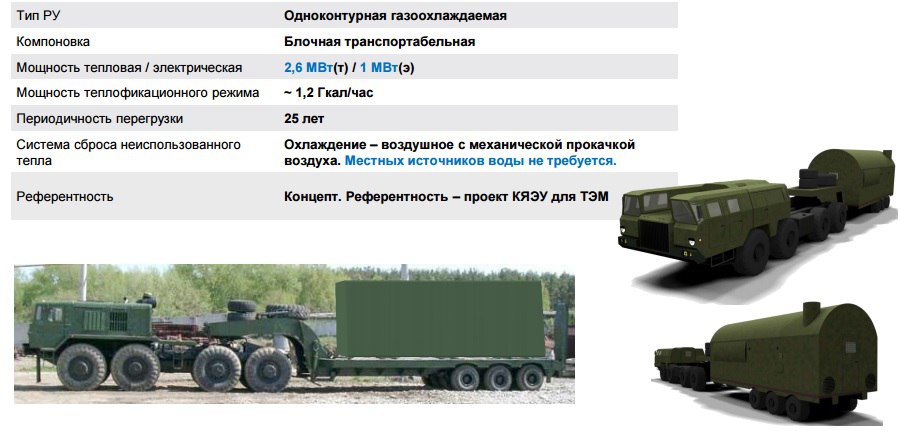
Russian military exoticism - concept.
Most MMPs, when compared with large reactors, are low-maintenance. In particular, the projects of such reactors suggest a longer interval between refueling (from 2 to 10 years versus 12–24 months for large power units) or laying fuel in general for the entire life cycle — for this it is necessary replacement of the compact reactor module.
Main advantages:
- The smaller power density of the reactor unit makes it, a priori, safer from the point of view of energy intensity (less power means less residual heat release after shutdown). From the point of view of the backend, relatively low amounts of accumulated radioactive waste.
- Power units of this type are less dependent on the availability of the possibility of collecting a large amount of cooling water nearby. Thereby, they are perfect for work in remote corners of the planet (and not only ), for example, generating energy for mining.
- The presence of a sufficient number of passive security systems. In a good way (in theory), these systems solve the main emergency problem - the loss of the final consumer of heat in the event of an accident. In fact, although the systems are passive, they also need constant supervision and maintenance. But it is necessary to recognize the greater stability of small switchgears to a typical situation - complete loss of power supply.
- Minimization of technically complex construction and installation works, taking into account the specifics of the regions of possible placement. The minimum amount of service. Reducing the number of required field attendants.
- The possibility of a significant simplification of the decommissioning procedure of these units.
Small reactors that have a close prospect of implementation (10–15 years) belong to the following types of vessel reactors: PWR (pressurized water-water), fast neutron reactors or high-temperature reactors (mainly with gas coolant).

From left to right: 1 - Westinghouse SMR. 2 - helium HTMR-100. 3 - fast PRISM.
Since most MMP projects are conceptual and require significant R & D in the future, in order to add specificity to my story, I’ll focus on two of the most relevant, ready-made projects.
1) NuScale (NuScale Power Inc., USA)
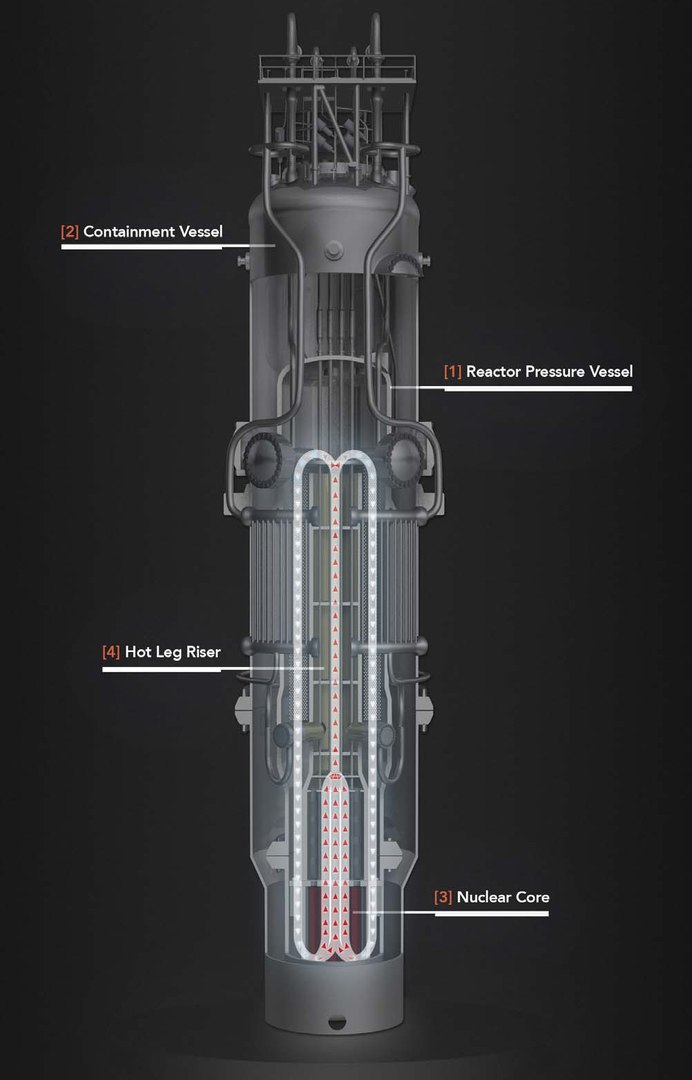
The project “NuScale Plant”, formerly called MASLWR, is a unit with a pressurized water reactor under pressure of low power - 45 MW (e).
It was developed jointly by the Idaho National Engineering Laboratory and the University of Oregon (USA). In 2007, NuScale Power Inc. was established to commercialize the project. The project has been developed since 2000. Since this is a modular reactor - 12 such modules are installed on the site as standard.

Reactor building. Sectional view.
The core, steam generators and pressure compensator are located within the same vessel, there are no circulation pumps. The case diameter is 2.9 meters, height 17.4 meters.
The heat carrier, heating up in the active zone, moves upwards, gives off heat in the steam generator, and goes back through the descending channels. Natural circulation, yes.
The core is recruited from fuel assemblies with a beautiful name NuFuel-HTP2. In fact, similar in design to the fuel assemblies for Western PWR units, the design. The technical assembly specification for the NRC is here . Overload plan to produce every 24 months.
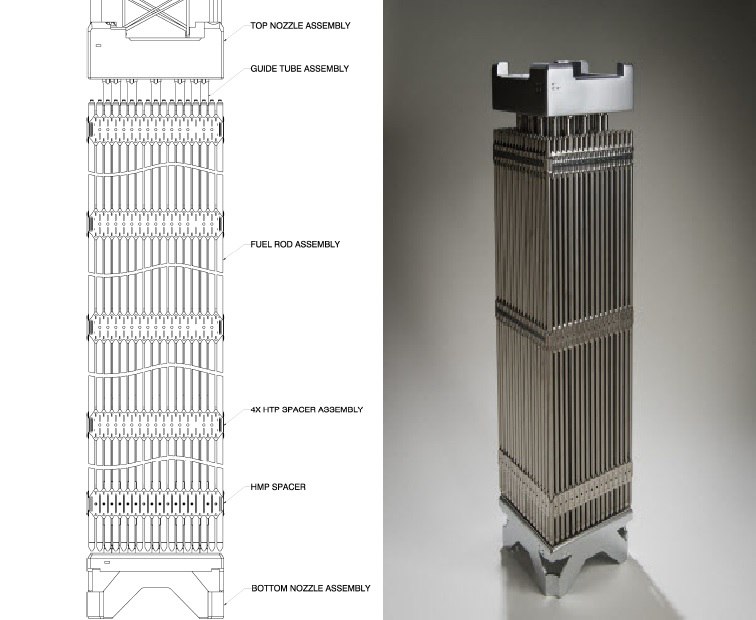
TVs reactor NuScale. Incidentally, the production AREVA.

Cartogram of loading of the NuScale reactor core.
The main distinctive feature of similar projects is that the reactor vessel is additionally placed in a thick-walled metal vessel made of stainless steel. All this design is in the pool, completely immersed in water. The residual heat removal system consists of two independent passive systems.
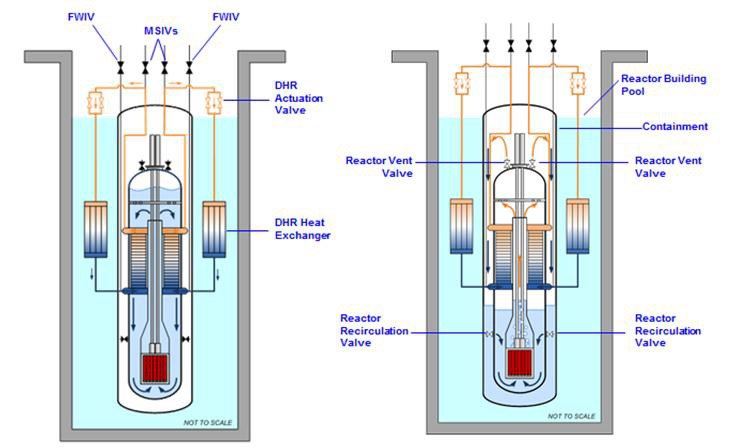
Systems of planned and emergency heat removal.
At the end of 2016, the company submitted a license application to the American regulator. This is the first application for a license for SMR in the United States. This fact means that at this stage the project is ready almost completely, and has the opportunity to become a very real sold product.
2) CAREM-25 (CNEA, Argentina)
Probably, the reader did not expect to see this country in the top of the DFID developers, but Argentina is now closest to operating a 25 MW demo modular reactor.
CAREM-25 is an integral type of PWR, construction of which began in 2014 adjacent to Atucha NPP. It is pleasantly surprising that this is Argentine technology, and 70% of the equipment and materials are planned to be received from local manufacturers.
The project was developed as an energy source for electricity supply in regions with low consumption. It can also be used for desalination plants.
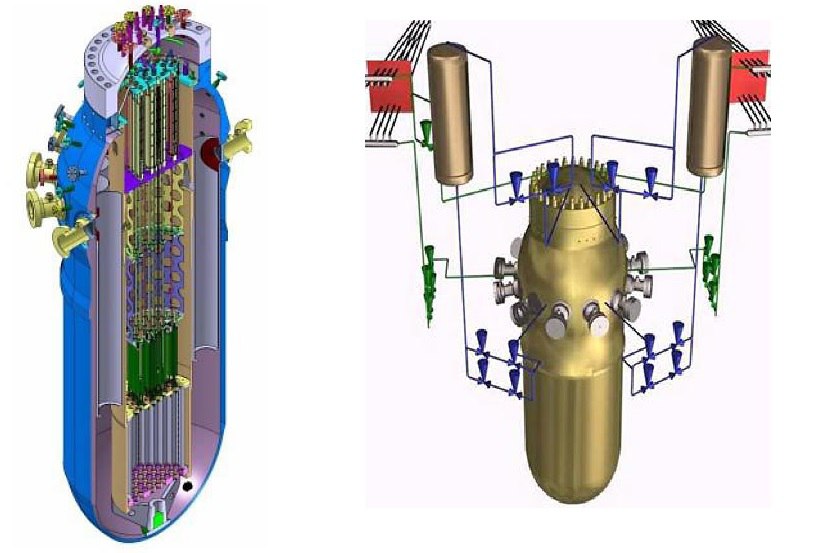
The reactor vessel and the main security system.
The core, hydraulic actuators of regulators, and twelve straight-tube vertical steam generators (with steam overheating) are located in one housing - according to all canons of modularity. In the first circuit - the natural circulation. The reactor vessel has a diameter of 3.2 meters and a height of 11 meters. The active zone is recruited from 61 hexagon (!) Fuel cassette.

CAREM-25 fuel assembly.
CAREM-25 contains passive and simple active security systems. The project stipulates that in case of a severe accident, the core remains intact for 36 hours without operator action and without external power supply. Estimated core damage frequency (CPAP) –10E-07 reactor / year.
The dividing chain reaction is stopped using two independent systems - control rods and a boron injection system in water. Under normal operating conditions, boron is not used.
The removal of residual energy release is a passive system PRHRS. Works on the principle of technological condenser (isolation condenser). PRHRS condensers are located in the basin at the top of the containment. The system provides heat removal from the core for 36 hours.
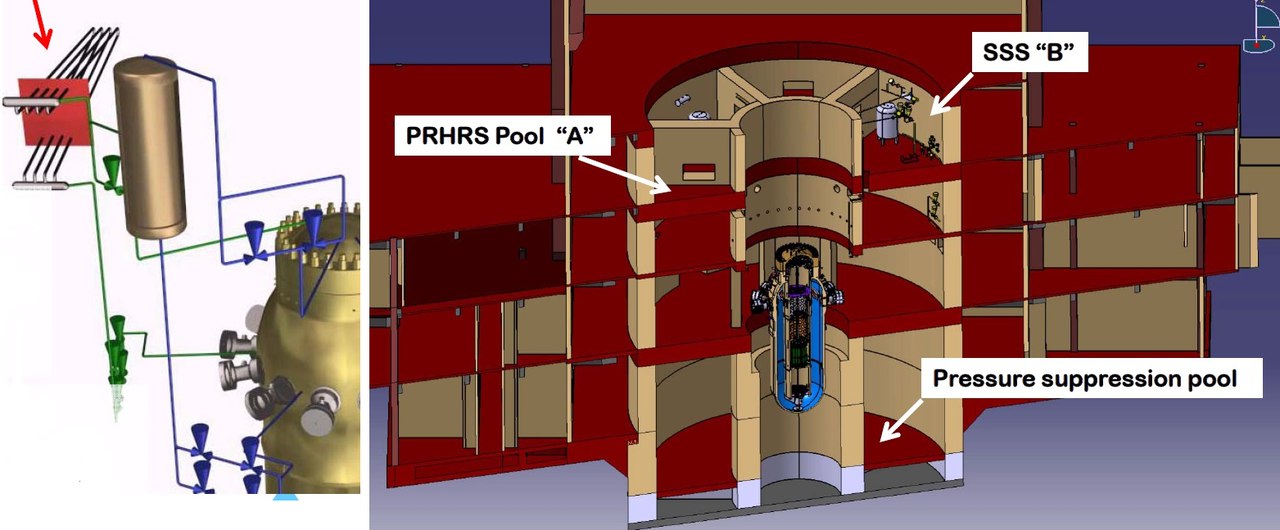
Technological condenser and pool system PRHRS.
The project also provides for a passive emergency system for pouring water into the EIS core in the event of a decrease in pressure in the case below the setpoint of 1.5 MPa - this pressure breaks the safety stop and borated water from the EIS system tank is poured into the case. In a simple way - hydroelectric capacity of ECCS.
The first download is scheduled for 2018.
There are a lot of questions for this project. For example, the reliability of 12 internal steam generators, the possibility of their inspection and repair.

And so the building of the power unit will look outside.
As a conclusion, it is worth noting that small reactors will allow to “recharge the motor” of the peaceful atom and give the industry new strength, while lower power, which means shorter construction times, will reduce the cost of generation and fight against the increasing popularity of renewable energy.
At the end of 2016, a consortium was created to implement the strategic objective of starting commercial operation of small reactors in the mid-2020s. It includes the following companies: AREVA, Bechtel, BWXT, Dominion, Duke Energy, Energy Northwest, Fluor, Holtec International, NuScale Power, Ontario Power Generation, PSEG, TVA and Utah Associated Municipal Power Systems. As you can see, there are several weighty players.
So it’s too early to talk about a bright future, but the positive dynamics is still visible.
Source: https://habr.com/ru/post/402055/
All Articles